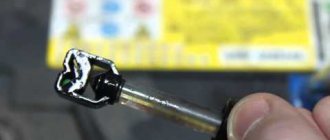In a modern car, the leading role at the moment the engine starts is played by the battery. The operation of the entire on-board electrical system depends on the good condition of the power source and its operational characteristics. It is also necessary that all output parameters, including capacity, voltage and number of amperes, are within normal limits.
What is current strength
Electricity in batteries is generated through chemical reactions during the interaction of an electrolyte (an acidic or alkaline solution of a certain density) and lead plates that act as electrodes. As a result, a current is formed - the ordered movement of charged particles. Current strength is usually called the amount of electricity moving in the cross section of a conductor per unit of time (second).
The classic version, under ideal conditions, assumes that the current strength throughout the entire circuit is constant. Practice proves that the final value is influenced by various external factors:
- ambient temperature;
- possible sources of electromagnetic radiation located nearby;
- complexity of the electrical circuit, etc.
For a car battery, an important parameter is the starting current, which in some sources is also called cold cranking current (Cold Cranking Amps - CCA).
In Russia, state standards have been established for manufacturers of automotive power supplies according to CCA. The lower threshold values of batteries are limited in GOST 53165-2008. According to the current standard, without landing, the battery is required to output below 9 V at the terminals for 30 seconds at an ambient temperature of -180 C.
A parameter such as the battery capacity is related to the amount of electricity. The value is measured in ampere hours. During normal operation, motorists are not recommended to discharge the battery below the minimum limit values. This will negatively affect the further operation of the device.
The capacity value helps to calculate the approximate period for the battery to return its charge. The capacity is directly dependent on the current strength, so during testing the discharge conditions are standardized. For most batteries, the capacity is 60 Ah, respectively, for a twenty-hour discharge the amperage will be 3 A, and for a ten-hour operation - 6 A. For a discharge current of 25 A, the typical battery capacity will be 40 A, providing power to the on-board system for 96 minutes.
Resistance
Ohm's law links current and voltage into another element - resistance. It is this resistance that is the path along which groups of charges can move from one side to the other. The larger it is, the narrower the path, so the flow is slower (lower current). The unit of resistance is Ohm.
Useful: Lead-acid batteries: charging and proper maintenance of car batteries
When calculating, voltage is usually denoted as U, current as I, and resistance R. If we want to express the relationship between these variables, we will use Ohm’s law, namely:
U = I * R
For example, across a 100 ohm resistor through which a current of 0.1 A flows there will be a voltage drop:
0.1 A * 100 Ohm = 10 V
Battery types
Before we find out how many amperes are usually in a classic 12-volt car battery, let's look at the types of power sources. There are the most popular battery options, such as acid and alkaline. In the first case, metal plates (electrodes) are immersed in a solution of sulfuric acid, and in the second case, the liquid is an alkaline solution.
For northern regions, it is not recommended to use alkaline power sources, as they do not perform well at low temperatures.
Regardless of how many amperes there really are in an alkaline car battery, they are available in two versions: nickel and lithium. The former may contain cadmium or metal hydroxide in combination. Due to their large dimensions, such devices are more in demand on electric forklifts or trucks, since there is more space for the placement of cells with a lower specific current compared to acid analogues.
Lithium power supplies are cheaper to manufacture, but in practice they are very sensitive to low temperatures. This equipment has proven to be in demand in electric vehicles.
Acid batteries are available in the following types:
- Antimony. Lead plates include more than 5% antimony. Although such a battery is capable of withstanding a significant number of discharges/charges, due to other disadvantages it is not used in modern cars.
- Low antimony. They are manufactured using a similar technology as antimony batteries, but with a lower percentage of antimony. They have better practical characteristics.
- Calcium. The plates in them are made with the addition of calcium compounds (without antimony). In some models, the electrodes include silver alloys. Power supplies are quite sensitive to frequent deep discharges, but have stable operating parameters.
- Gel or AGM batteries. This technology assumes that the electrolyte is in a jelly-like (gel) state. Such models are significantly higher in price than liquid analogues - 2–3 times. Their advantages are high resistance to frequent deep discharges and good output parameters, but their disadvantages are the need for a high-quality charger with reduced current parameters and stable consumers.
Voltage
Voltage is expressed in volts, written [V]. Imagine two warring dogs, kept on leashes by their owners. These dogs represent groups of electrical charges and the force they pull is voltage. The greater the force of interaction between them, the greater the tension. Therefore, it makes no sense to talk about tension only at one point - it is always determined between two points.
Likewise, the height of hills is given above sea level (that is, the measure extends between the surface of the sea water and the top of the mountain) or relative to another point, such as a city located at its foot. In both cases these are the same high parts, but measured differently.
The same thing with voltage: measured relative to one point in the circuit will have one value, and relative to another - a different value. Therefore, electronics accepted the existence of the so-called mass, that is, the point from which we measure all voltages. We measure them using a voltmeter connected in parallel to the voltage source.
Tension can exist “on its own.” For example, we buy a 1.5 V battery and it has a voltage close to the nominal voltage between the terminals. If we leave it lying in the closet, the voltage at the battery contacts will remain the same after several days, months or even years. Over time, of course, the voltage will decrease as a result of chemical processes occurring inside the cell.
Number of amperes in a charged car battery
The battery capacity is indicated on the battery case or in the operating instructions (passport). Let's look at how to independently check the indicated amps on your battery. Capacity is important for a motorist, since it can be used to find out how much charge the battery will have time to deliver over a certain period of time. The parameter is measured in ampere hours.
Monitoring is carried out under load and without it. The readings are given by a multimeter, and a regular lamp serves as the load. A charged battery should show good performance when the light stays on for a long time, but if it quickly starts to go out, then the battery is faulty. In such testing, we recommend taking a 35–40 W lamp and holding it for about 2 minutes.
A car battery that was charged before measurements and after loading produced a voltage above 12.4 V can be considered serviceable. If the values are reduced, you should consider purchasing a new power source.
Most power sources located in the engine compartment of passenger cars have a capacity of 55–65 Ah. This is quite enough to start the engine in any weather. However, it is worth considering that a car parked in a garage or parking lot gradually consumes current for small needs, for example, a clock on the dashboard, alarm system, central locking, injection controller, etc. If the total volume of consumers does not exceed 50–70 mA, then this will not prove critical. Otherwise, you need to think about reducing current consumption or buying a more powerful battery that can produce more energy.
Battery use
There are many types of batteries that are used in various gadgets, areas and systems:
- In the energy sector, telecommunications equipment substations, and stationary lead batteries are used as an emergency power source for railway crossings.
- Nickel-cadmium batteries are used to power mining hoists, communications equipment, and to start diesel stations and aviation engines.
- Nickel-metal hydride batteries are used for autonomous power supply of portable devices.
- Portable devices such as mobile phones, speakers, cameras are powered by Li-ion batteries.
- Some portable gadgets may be equipped with lithium polymer batteries. They are usually positioned with increased safety and increased service life compared to Li-ion.
For several decades in a row, Li-ion batteries have been considered the best for small devices due to fast charging, higher capacity relative to size, lighter weight and longer service life.
How to charge a car battery
There are several ways to charge the battery in a car. In the first case, you can make do with the built-in equipment in the car. It is enough to start the engine without removing the battery and drive it at high speeds for about 10–15 minutes. It is necessary to carry out such an operation not in garages or closed boxes, but in the open air, so as not to be poisoned by toxic exhausts.
We recommend that the event be carried out during the daytime to avoid the use of electric lighting devices. You also need to turn off the audio system, heated windows, mirrors, steering wheel, seats and other electricity consumers.
In the second case, you will need an external charger. It is preferable to remove the battery from the car and charge the battery by placing it on a flat horizontal surface. Next we carry out the following actions:
- in serviced batteries, we slightly unscrew the plugs to ensure gas escape, and in unserviced batteries, we check the gas outlet holes;
- connect the positive contact of the charger to the positive terminal, and the negative contact to the negative terminal;
- turn on the device and set the current on it to 1/10 of the capacity, for example, a 55 Ah power source requires a current of 5.5 A, and a 60 Ah unit requires a current of 6 A;
- we leave the connected battery for about 9 hours, monitoring the degree of charge, since the exact time depends on the performance characteristics of the battery and the output parameters of the charger;
- After turning off, you need to let the battery stand for 15–20 minutes so that all the gas comes out, and only then tighten the plugs until they stop.
A fully charged battery gives, after measurements with a multimeter at the terminals, 12.6–12.7 V without a connected load. For a regularly used battery, normal values are in the range of 12.3–12.2 V. You should not allow acidic devices to significantly discharge, as this will negatively affect their service life.
Battery reserve capacity
A car battery is characterized by a parameter called reserve capacity, which indicates how long the car will last if its generator suddenly fails. In this case, the machine will have to be operated:
Charger
- in the rain;
- blizzard;
- Night time.
The reserve capacity is typically approximately twenty-five amps when charging the battery. This parameter is approximately equal to the current consumed by a car's gasoline engine, while the best battery is considered to be the one that provides a reserve capacity of one hundred and ten minutes. With this reserve power, the car will be able to cover at least a hundred kilometers in two hours, even if its generator completely fails.
Electrolyte density
The choice of the optimal electrolyte density depends on a number of factors, among which climatic conditions are decisive. For different regions of the country, this indicator is selected taking into account the following setting data:
- in areas with a temperate climate it should be at the level of 1.25-1.27±0.01 g/cm3.
- in regions with cold winters with temperatures down to minus 30 degrees, this indicator is selected based on 0.01 g/cm3 more than the previous value;
- in areas with a hot subtropical climate, its value should be 0.01 g/cm3 less.
Additional information: In regions where severe frosts are common (down to -50 °C), in order to avoid freezing the battery, you will have to increase the density from 1.27 to 1.29 g/cm3.
Data on electrolyte density are given in special tables published in many sources on the Internet.
Density table
A general view of the summary data is given below:
Density indicators are given divided by climatic zones. They also vary depending on the electrolyte condition. The second column indicates the value for the poured (fresh) solution, and the third - after charging the car battery with the selected charging current value.
The required density value during charging and after it is selected with a small margin in the direction of increase. This allows you to take into account an accidental drop in temperature and eliminate the possibility of the battery freezing in winter. In summer, you should do the opposite - choose a lower value. Otherwise, the increased density may lead to boiling of the solution.
| CLIMATE AND SEASON WHEN MEASURING ELECTROLYTE DENSITY | DENSITY (g/cm3) | ||
| Battery charged | Battery discharged | ||
| By 25% | By 50% | ||
| Very cold (temperatures in January range from -50°C to -30°C) | 1,30 | 1,26 | 1,22 |
| Cold (temperature in January from -35оС to -15оС) | 1,28 | 1,24 | 1,20 |
| Moderate (temperature in January from -15°C to -8°C) | 1,28 | 1,24 | 1,20 |
| Warm humid (temperature in January from 0°C to +4°C) | 1,23 | 1,19 | 1,15 |
| Dry hot (temperature in January from -15оС to +4оС) | 1,23 | 1,19 | 1,15 |
In this situation, you should learn to find the “golden mean” between two extremes. On the one hand, high density is fraught with a reduction in battery life. On the other hand, its low indicator leads to a decrease in voltage and difficulty starting the engine. At the same time, we should not forget that when choosing the desired density, the battery capacity must be taken into account.
Monoblock
You can assemble a battery from individual batteries using a copper wire or a bus bar with terminals. This process, although simple, is still quite labor-intensive, so ready-made monoblocks are made in factories. They consist of several elements assembled in one case made of durable plastic. Monoblock lead-acid batteries typically consist of 6 or 12 individual cells. The voltage is 12 V or 24 V, respectively.
Monoblock
All elements of the monoblock are no different from each other, and they age simultaneously, so the service life of the monoblock is longer than that of each individual battery. In the process of assembling a monoblock, it is possible to use both parallel and serial connections of its individual elements.
Note! Battery life is measured not in years or months, but in the number of charging cycles. To ensure that the battery lasts as long as possible, it is advisable to recharge it after using only a small part of its rated capacity.
How to connect batteries to increase the total capacity?
To achieve the goal of increasing the technical characteristics of the power source during operation of the device or device, there are options for different connections of the elements of the electrical circuit.
There are two connection methods or schemes:
- Serial connection.
- Parallel connection.
The battery capacity for serial and parallel connections will be different. The first method will increase only the total voltage, and the second will increase the total C b as many times as there are elements in the circuit:
C∑ = C1 + C2
Before starting the experiment, you need to take two battery power supplies with the same degree of wear and charging, and two diodes. For a parallel connection, the minuses of the batteries need to be connected together, and the plus of one to the anode of one diode, plus the other to the anode of the other. The cathodes of the diodes also need to be connected to each other. Turn on the load with a minus at the connection point of the negative terminals of the elements, with a plus at the junction of the diode cathodes. This connection scheme will double C b. It is impossible to assemble such a circuit without diodes, since the batteries will discharge one through the other.
The consequences of a deeply discharged battery and how to properly charge it after that
When the battery is deeply discharged, the plates become sulfitized. Large crystals of lead sulfate (PbSO4) are deposited on the positively charged battery plates, thereby clogging them. In this case, the surface area of the plates free from lead sulfate crystals is greatly reduced. As a result, the battery capacity decreases. Three or four full discharges and almost all the plates will be clogged, and the battery can be thrown away.
Battery plates clogged with lead sulfate crystals.
Under normal operating modes (charge - discharge), small crystals are formed and during charging they dissolve in the electrolyte. This way the plates are cleaned and the battery capacity is restored. This does not happen if the battery is deeply discharged, since during normal charging large crystals of lead sulfate practically do not dissolve in the electrolyte. In this case, to dissolve them, you need to use a different charging mode.
How to replace the nipple (nipple) on a tubeless tire yourself without removing the wheel.
A deeply discharged battery should be charged with a voltage of 16.2 - 16.3V and a low current of 1-0.5A. In this charging mode, partial restoration of the battery capacity is possible. In one cycle, it will not be possible to restore the battery and increase the electrolyte density to 1.27 g/cm3. Therefore, when the electrolyte begins to boil at low currents, the charge must be stopped and allowed to stand for 2-3 hours. After this, we repeat the charging again. We repeat this process several times. In this way, it is possible to increase the density of the electrolyte to the state of a fully charged battery.
But we should not forget that voltages above 14.5V are not suitable for all batteries. These include gel and hybrid batteries.











